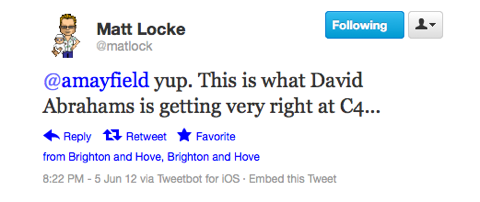This post is a reflection on two articles I suggest reading together – one a model for audience development, the other evidence of an innovative media owner putting this
approach into practice.The first, is a post by Ben Elowitz, CEO of a company called Wetpaint, which calls on brand and media owners to Forget About ‘Content Management’ – And Focus on ‘Audience Development’.It’s a great insight: we can still too often be in a broadcast age mindset about audiences, thinking that they belong to the platform – Facebook, the TV channel, the magazine – rather than to the brand.
Elowitz is saying that in focusing on content management, sometimes the audience gets forgotten or is treated as unknowable, unreachable other. To put it another way: audience is seen (and measured in reach, impressions and clicks) as outcome of content and campaigns, rather than the focus of digital media.He usefully compares media to more systematised business functions like ERP (
Enterprise Resource Planning), which made the shift from inventory management (what we have in stock) to more sophisticated, data- and process-led approaches which “manage and even stoke demand”.Elowitz says a evolution will take place in digital media:
The next generation of CMS won’t be CMS 2.0. The technology that powers media companies going forward will be ADS: audience development systems. And it will help media companies that use it multiply their topline and improve their offering to their audience.
He also puts his finger on something really important about understanding the value of inbound marketing or earned media efforts:
Digital distribution, when done right, can have a multiplicative effect: a great piece of content delivered to the right person at the right time in the right package is worth 10x that same content paired with the wrong (or non-existent) distribution strategy
To my mind the effect is also cumulative: the bigger the audience or network you are attracting, the more opportunities you will have to grow that audience through word of mouth and social media connections.
Channel 4’s new relationship with its audience
Which brings us nicely to the other article, I mentioned – the transcript and report of Channel 4 Chief Executive
David Abraham’s speech to the Royal Television Society. I was prompted to take a look at this after Tweeting about the previous blog post and getting this reaction from
Matt Locke:
In his speech, Abrahams voices the anxiety of his industry about the vulnerability of TV companies because of their traditional relationship with their audience and the advertising model that goes with it (see my post
“Gravity-defying” TV advertising in danger of a crash) being threatened. The Guardian reports that Abrahams said:
audience data is the “new oil, or soil, of television” and that as viewing behaviour becomes increasingly measurable through interactivity in the future advertiser-funded public service broadcasters – Channel 4, Channel 5 and ITV – risk being left behind.
His analysis is both realistic about a broadcaster’s place in the new digital ecosystem – “in many ways a subset of a converged content and technology sector that dwarves it” – and is optimistic that Channel 4 can innovate new ways of creating value for both audiences and advertisers.That optimism is well-founded, because the new models of value exchange between brands, media and audiences are still very much up for grabs.Matt Locke (himself a former commissioner at Channel 4) put forward a thesis at
Media Future Dublin (see
my post on his talk: “May We Have Your Attention, Please“) that measurement for different kinds of media and audience attention help define the business models that grow up around them. None of the new giants of the content and technology sector, nor the advertising industry as a whole, have settled on a model for measuring the value in the audiences for online content.While this remains in flux, the field is wide open for Channel 4 to innovate and develop new models alongside what Abrahams calls the BARB (TV ratings) “gold standard”. This is a vision backed up with investment – as the broadcaster says in its press release about its
Audience, Technologies and Insights strategy:
Building the required infrastructure to deliver these ambitions now begins in earnest with a multi-million pound investment in a bespoke Channel 4 viewer database and new senior roles in the Audience Technologies and Insight team.
What this means for brands
We should keep a close eye on how this develops – there are going to be lessons aplenty for anyone in digital media, brands and producers alike.These are some of the insights to take away from this pair of articles:
- Next-gen advertising opportunities with media companies: Channel 4 will be developing the next generation of TV advertising, re-casting what that term even means. Brands which are innovative, adventurous and understand the value of data and developing audiences will be best placed to work with them and reap the benefits…
- Build systems and infrastructure to “scale social media”: Just as Channel 4 is investing in the analysis and insights to understand how it can develop audiences, so should brands. Talk about “brands as publishers” focuses on the idea of brands creating and owning content, but we need to acknowledge that this isn’t enough, that publishers and media companies like Channel 4 are looking at developing these systems with as much urgency as they are looking for brilliant new creative ideas for content. You can’t have one without the other.
- Data is a major asset: Abrahams talks about “ad agencies gearing up and making very big investments in this area [data retention and analytics]. I don’t think broadcasters have grasped that our data is a public asset.” I’m not sure many brands have grasped this either – ownership of the data and the insights remain with the digital platform owners and agencies.
- Respect the audience’s data: There is an implicit contract with audiences – you do these things with them, not to them. Channel 4 stresses the need for a kind of partnership with the audience and to be transparent about why you need their data and what you are doing with it.
- Build your business case around ‘multiplicative effect’: Growing an audience creates a network (to distribute content) and network-effects (past a certain point growth accelerates). In building an audience, you are creating value which can be sustained and grown. Measure the impact of a piece of content or a campaign in isolation and you are missing out on recognising the longer term value you are creating.



